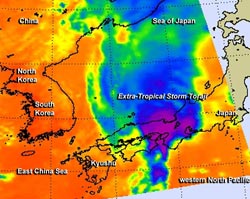

The Atmospheric Infrared Sounder or AIRS instrument captured infrared data of Extra-Tropical Storm Toraji as it continued tracking through southern Japan on Sept.4 at 0429 UTC/12:29 a.m. EDT.
AIRS showed that the coldest cloud top temperatures and strongest thunderstorms with heaviest rainfall stretched from Hyogo Prefecture in the southwest to Shiga Prefecture to Gifo Prefecture in the northeast.
At 1500 UTC/11 a.m. EDT on Sept. 4, Toraji had maximum sustained winds near 40 knots/46 mph/74 kph. It was centered near 32.7 north and 132.9 east, about 114 nautical miles/131 miles/211 km south of Iwakuni, Japan. Toraji has increased in forward speed over the last day and was moving to the northeast at 22 knots/25.3 mph/40.7 kph.
The Joint Typhoon Warning Center's multi-level analyses indicated that Toraji is now an extra-tropical cold-core low pressure area, and it is linked to a fast moving frontal boundary. That frontal system is moving across Japan and will carry Toraji's energy with it.
Text credit: Rob Gutro
NASA's Goddard Space Flight Center












